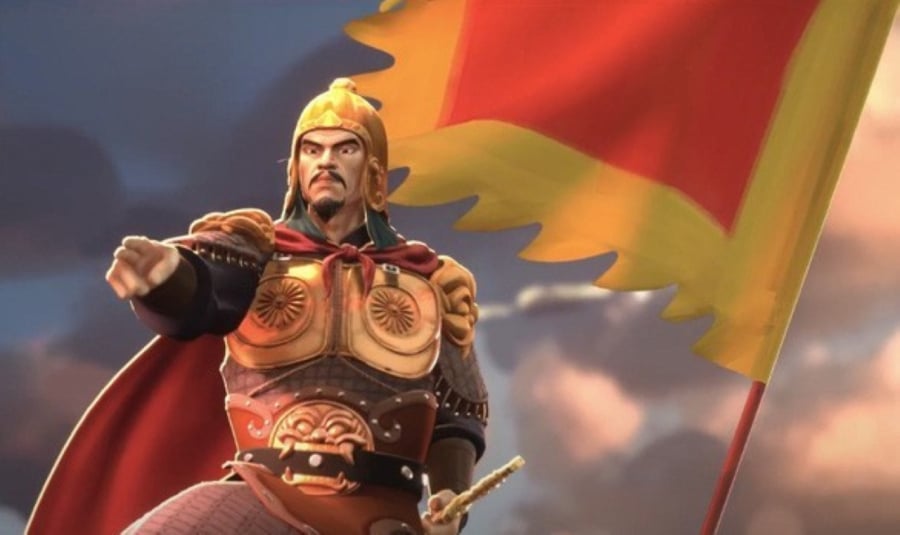The historical records indicate that the present-day Minh Duc town was once the ancient village of Trang Kenh, part of Duong Dong total, Thuỷ Duong district (Kinh Mon prefecture, Hai Duong town).
The Bach Dang River was the site of three pivotal naval battles led by Duc Vuong Ngo Quyen, King Le Dai Hanh, and Hung Dao Dai Vuong Tran Quoc Tuan, who decisively defeated foreign invaders, dashing the expansionist dreams of northern forces.
1. Ngo Quyen – The Rout of the Southern Han in 938
According to historical documents, in 938, the King of Southern Han sent his son, Liu Hong Thao, to command a naval invasion of our country.
‘Dai Viet Su Ky Toan Thu’ chronicles the strategy of Duc Vuong Ngo Quyen: “They have the advantage of boats, and if we don’t prepare, the outcome is uncertain. If we send people to plant sharp stakes, with iron tips, hidden at the river mouth, when their boats follow the tide in, they will be trapped, and we can easily control them, not letting any escape.”

Ngo Quyen Commanding the Naval Battle, Routing the Southern Han Forces in 938 (Illustration)
At the Bach Dang River mouth, Duc Vuong Ngo Quyen mobilized thousands of soldiers and local people to build a stake field to ambush the invading forces. More than three thousand wooden stakes, sharpened and iron-clad, were driven into the riverbed along a three-mile stretch.
In late 938, Hong Thao’s fleet arrogantly sailed into the Bach Dang estuary. Ngo Quyen sent light boats to challenge and lure the enemy, enticing them to pursue and pass through the stake field into our ambush.
As the enemy fleet passed through the river mouth, the tide receded, and our forces counterattacked fiercely. The stake field emerged to halt the enemy boats, many of which were pierced by the stakes, collided, and sank. Hong Thao and more than half of his soldiers perished.
Following this glorious victory, in 939, Duc Vuong Ngo Quyen ascended the throne, becoming Ngo Vuong, founding the Ngo dynasty, and establishing his capital in Co Loa (present-day Dong Anh, Hanoi). The great victory at Bach Dang in 938 is etched in our nation’s history as a shining triumph, ending over a millennium of domination and ushering in a prolonged era of independence for Vietnam.
2. King Le Dai Hanh – The Crushing Defeat of the Song in 981
In late 979, Dinh Tien Hoang and his heir, Dinh Lien, were assassinated, leaving the five-year-old Dinh Toan to ascend the throne. The Dinh dynasty weakened. Seizing the opportunity, the Song dynasty aggressively prepared to invade our country.
Confronted with this national crisis, the court enthroned Le Hoan as king (King Le Dai Hanh), establishing the Early Le dynasty in 980. He adopted the reign name Thien Phuc, retaining the country’s name as Dai Co Viet, and established his capital in Hoa Lu. He stabilized the internal situation and deployed troops to guard critical locations.

King Le Dai Hanh Commanding the Naval Battle, Achieving a Great Victory Over the Song Forces in 981 (Illustration)
According to researchers, in January 981, the Song navy, led by Hou Renbao, surged into the Bach Dang River. King Le Dai Hanh personally led the army, building Binh Lo fortress and ordering soldiers to drive stakes into the river, exploiting the treacherous terrain of the Bach Dang River.
After their defeat at Binh Lo, the Song forces returned to the Bach Dang River, only to fall into King Le Dai Hanh’s well-prepared ambush.
Historian Le Van Lan believes that the battle’s center on April 28, 981, took place in the river and mountain region of U Bo and Trang Kenh. Our forces from various river branches converged on Bach Dang, fiercely engaging the Song army. Hou Renbao was killed, and a small number of enemy troops fled to the sea.
3. Hung Dao Dai Vuong Tran Quoc Tuan – The Sinking of the Mongol-Yuan Forces
In the 1288 battle against the Mongol-Yuan forces on the Bach Dang River, Hung Dao Dai Vuong Tran Quoc Tuan personally oversaw the battlefield preparations in Trang Kenh and neighboring villages.
According to historical records, in March 1288, upon learning of the enemy’s intention to withdraw by water via the Bach Dang River, Hung Dao Dai Vuong Tran Quoc Tuan commanded the people of Dai Viet to create a massive ambush on the river. Lim and tau wood from the forests were brought to the riverbank, sharpened, and driven into the riverbed towards the sea, creating vast stake fields.

Hung Dao Vuong Tran Quoc Tuan Commanding the Naval Battle, Sinking 60,000 Mongol-Yuan Soldiers in 1288 (Illustration)
The water and land forces secretly hid behind the mountain range in Trang Kenh along the Bach Dang River.
On the morning of April 9, 1288, as O Ma Nhi’s fleet entered the Bach Dang River during high tide, the Dai Viet navy engaged them, feigning defeat and retreat. Falling for the ruse, the enemy fleet ventured deeper into the Bach Dang River, straight into the stake field.
Our forces waited for the tide to recede before turning their boats around and directly attacking the enemy formation. The Dai Viet navy from all directions swiftly moved to block the enemy on the Bach Dang River.
Trapped, many enemy ships were burned and pierced by the stakes. Some enemy troops abandoned their boats and fled ashore, only to fall into another ambush by the Tran army. Over 600 ships and approximately 60,000 enemy soldiers were utterly annihilated.





































